A cultural tourism and marketing initiative developed by the Nisg̲a'a Lisims Government boosts tourism in the Nass Valley, raises the profile of its entrepreneurs, and reinforces the sovereignty and culture of the Nisg̲a'a Nation.
Written on the Land: Cultural Tourism in Nisg̲a’a Territory
Estimated Reading time

29 Mins
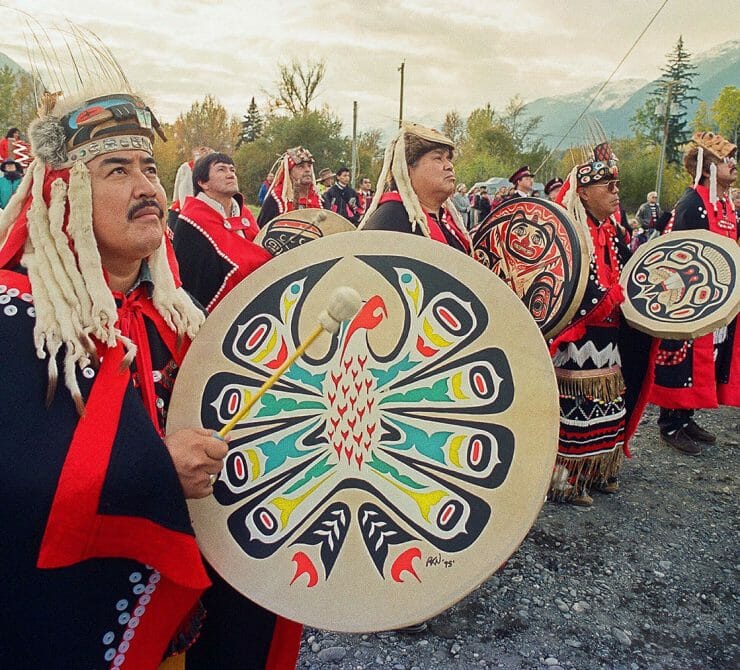
The Nisg̲a’a territory covers 200,000 hectares and reaches from the mouth of the K’alii Aksim Lisims (the Nass River) to the Hazelton Mountains. The main communities are located in the Nass Valley and in the villages of Ging̲olx, Gitlaxt’aamiks, Gitwinksihlkw and Laxgalts’ap.
At a Glance
The Nisg̲a’a Highway, running through the heart of the Nation’s territory from Terrace to Gingolx, was given the numeric designation 113. The number was not chosen arbitrarily; from 1887 when Nisg̲a’a chiefs travelled to Victoria to demand recognition of title, to 2000, when the Nisg̲a’a Treaty was ratified and the Nisg̲a’a Lisims Government passed its first law, exactly 113 years had passed. Over the next five years, the Nisg̲a’a Lisims Government would extend and upgrade the highway, connecting the four villages of its Nation and inviting the world to visit Nisg̲a’a territory.
The Nisg̱a’a territory, encompassing 200,000 hectares from the K’alii Aksim Lisims (the Nass River) to the Hazelton Mountains is astounding in its beauty. It is a place of aquamarine waters, soaring snow-capped mountains, and an enormous lava field. The story of the Nisg̱a’a people is written on the land, so visitors to the territory are offered more than breathtaking scenery—they are offered the opportunity to experience Nisg̱a’a culture.
Visitors to the Nass Valley are greeted by Txeemsim, a super-natural being who brought light to the Nass River in a time that the Nisg̲a’a lived in semi-darkness. His image is the centrepiece of a recent cultural marketing and tourism initiative by the Nisg̲a’a Lisims Government. The initiative expanded and enhanced an auto-tour route along the Nisg̲a’a Highway, developed a brochure to guide visitors along the route, and built a website devoted solely to tourism in Nisg̲a’a territory. The project and the partnerships that developed as a result have boosted tourism in the Nass Valley, raised the profile of entrepreneurs in the four Nisg̲a’a villages, and reinforced the sovereignty and culture of the Nisg̲a’a Nation.

The Nisg̲a’a Treaty Makes Tourism Achievable
The Nisg̱a’a territory has been dramatically shaped by the volcanic eruption of Tseax Cone. The eruption 263 years ago—Canada’s most recent volcano—irrevocably moulded the surrounding landscape and lives of the Nisg̱a’a people. The lava traveled into the nearby Tseax River, damming it and forming Sii T’ax (Lava Lake). It traveled 11 kilometres north to the Nass River filling the valley floor for a further 10 kilometres. Two villages were destroyed and 2000 people perished.

Nisg̱a’a oral tradition tells of how, as people watched the lava destroy their villages, Gwaxts’agat (a powerful supernatural being) suddenly emerged to block the lava’s advance. For days, Gwaxts’agat fought back the lava by blowing on it with its great nose. Finally, the lava cooled and Gwaxts’agat retreated into the mountain where it remains to this day.
It is into this story that visitors arrive as they enter Nisg̱a’a territory. The land, with its storied and scenic landscape, is a perfect fit for a tourism initiative. And tourism, with its many cultural and economic benefits, is an ideal undertaking for the Nisg̱a’a Lisims Government.
The Nisg̱a’a tourism initiative is part of a growing trend across the country. Since 2002, the Indigenous tourism sector in Canada has grown by more than 66 per cent. In 2017, the Indigenous tourism sector in British Columbia accounted for approximately $705 million in gross direct output to the provincial economy. Many First Nations are seeing the potential for tourism to support cultural revival, intercultural awareness, and economic growth in their communities.
Bert Mercer, economic development manager for the Nisg̱a’a Lisims Government, recognized the importance of tourism in the Nass Valley. It was Mercer that conceived of and developed the cultural marketing and tourism initiative with a team he assembled. He notes that tourism was the fastest growing industry in the region and saw the economic and cultural potential for his Nation. “We needed to develop and invest in tourism infrastructure,” he says. “The whole idea was to draw people in to the Nass Valley. We already had the volcano tour, the Nisg̱a’a Museum, we just had to package everything together.”
In the past, a tourist would drive into the valley, not really realize what was there and what wasn’t…it was difficult for them to travel around and really access the villages.

Before the Nisg̱a’a Lisims Government could undertake a large-scale tourism initiative it needed to develop and enhance its existing infrastructure, like Highway 113. The Treaty negotiated between Nisg̱a’a Lisims Government and the governments of British Columbia and Canada laid the groundwork for the Nation to enhance the Nisg̱a’a Highway. Prior to the treaty-signing, the highway was unpaved, and connected to only three of the four Nisg̱a’a villages.
Jim Skipp, a contractor for the Nisg̱a’a Lisims Government and owner of Skipp Design, who has worked for the Nisga’a Lisims Government for 32 years, says that prior to the treaty the Valley could not effectively support tourism. “In the past, a tourist would drive into the valley, not really realize what was there and what wasn’t, run out of gas, get a flat tire, not have brought water. So it was difficult for them to travel around and really access the villages.”
Maintenance and management of the Nisg̱a’a Highway 113 was a central component of treaty negotiations. Two years after the treaty was signed, the highway was extended to connect the village of Gingolx to the rest of the Nisg̱a’a Nation and to the wider North American road network. In 2005, the highway was upgraded to a paved, two-lane highway.
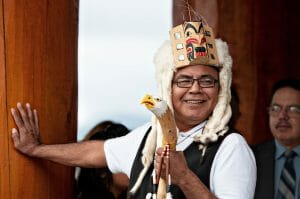
Without the treaty, and the subsequent highway improvements, it would have been much more challenging to develop tourism in the region. Mercer points out that highway traffic to the Nass Valley is key to supporting tourism and the many businesses that exist in the area. Drawing visitors in to drive from Terrace to the four villages of the Nisg̲a’a Nation, was a key objective of the government’s marketing and tourism initiative.
Driving the Nisg̲a’a Highway into the Heart of Nisg̲a’a Culture
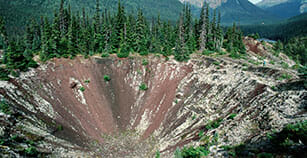
“We are Nisg̲a’a, people of the Nass River…Ours is a world of teeming inlets, dense forests, and sleeping volcanoes. It is a land that is as much a part of us as our own flesh and blood. Flowing through this land and our lives is Lisims, or “the Nass River” as it has become known in modern times. The resources of the Nass Valley have sustained our people for millennia.” – From the Nisg̲a’a Lisims Government website.
The Nass River has always supported citizens of the Nisg̱a’a Nation. Today, the people of the Nass River continue to benefit from the beauty and bounty of the river and its surrounding lands in part by inviting outsiders to experience the land and its stories.
The Nisg̱a’a cultural tourism and marketing initiative was conceived by Mercer as a way to expand the economic base of the Nation, link the four Nisg̱a’a villages and raise their profile as a collective unit, and to build partnerships with nearby communities. The centrepiece of the initiative was an 18-stop auto-tour along 100 kilometres of the Nass Valley.
The auto-tour takes visitors to culturally significant stops, all within an easy walk of the Nisg̱a’a highway. Stops include the Hlgu Isgwit hot springs hot springs, Ts’itksim Aks (Beaupre) and Ts’itksim Aks (Vetter) waterfalls, Wilp-Adok-shl Nisga’a (the Nisg̱a’a museum), and the four Nisg̱a’a villages of Gingolx, Laxgalts’ap, Gitwinksihlkw, and Gitlaxt’aamiks. The accompanying auto-tour brochure and tourism website provide deeper cultural context including Nisg̱a’a language translation for all stops.
One of the most popular spots on the tour is the Hlgu Isgwit hot springs. The springs are the dwelling place of the spirit of Sbi Naxnok and are a designated heritage site; their sulfur smell is said to be the smell of the spirit. The hot springs were recently upgraded, with funding

support from Coast Funds, and features two cedar tubs and a natural spring.
Mercer himself has an affinity for the hot springs, but has a hard time choosing a favourite stop on the tour. “I have a passion for the hot springs, and put a lot of work into their development. But I like the volcano walk too…you can walk right up to the volcano and step right onto the cone. You can stand up at the top.”
Visitors to the Nation are now linked to all four villages and to interesting stops.

Mercer is confident the initiative is having a significant impact on tourism in the region. Perhaps most noticeably is a significant uptick in visitors to the hot springs. “Even though it’s cold out right now, we probably get about 25 to 30 people from outside [the Nass Valley] on the weekends.”
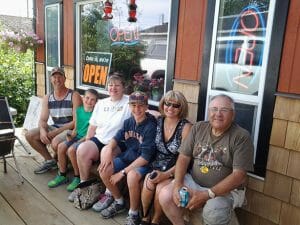
Stephanie Halapija, curator for Hli Goothl Wilp-Adokshl Nisg̲a’a (the Nisg̱a’a museum)—stop 16 on the tour—says she’s seen a major increase in traffic in recent years. In 2015, the museum had 1500 paid visitors and by 2017, that number had increased to 4000.
Local entrepreneurs are seeing the benefits from the increased traffic. U See Food U Eat it, a local diner in Gingolx, funded by Coast Funds, is gaining international recognition; visitors are starting to return each summer from Europe.
Mercer easily lists a number of functions of the auto-tour and the role it plays in enhancing tourism for the Nation. He says the auto-tour signs create driver awareness through improved wayfinding, stimulates interest in Nisg̱a’a culture, and provides visitors with cultural, social, and geographic interpretations of the Nation.
Skipp, who worked for Mercer to design the auto-tour signs and brochure, agrees. “Visitors to the Nation are now linked to all four villages and to interesting stops,” he says. Skipp notes that the tour’s design reflects the Nation’s ambition to follow international wayfinding standards. “We’re trying to make sure we don’t see that lonely tourist on the edge of the road like I have for 32 years. Through Bert’s direction we’ve been able to realize that vision.”

The Symbiotic Relationship Between Tourism and Culture

One of the strongest aspects of the marketing and tourism initiative by the Nisg̲a’a Lisims Government is its focus on culture. Mercer’s initiative has tapped into an existing desire by tourists to participate in authentic cultural experiences. The auto-tour, brochure, and website displays Nisg̲a’a culture front and centre. Mercer worked closely with the Ayuukhl Nisg̲a’a Department and the Council of Elders to craft the Nisg̲a’a language portion of the signs, brochure, and website.
According to Aboriginal Tourism BC, in 2010 3.7 million visitors to Canada spent $40 million experiencing Indigenous culture.
Halapija sees this desire in many of the visitors to the Nass Valley and to the museum. “Cultural tourists who come up here want to know about Nisg̱a’a traditions in a very authentic way,” she says. “They don’t want to be spoon-fed inauthentic touristy content.”
The Nisg̱a’a tourism and marketing initiative exemplifies Indigenous cultural tourism, the symbiotic relationship between Nations who want to share and strengthen their culture and visitors who want to experience an authentic culture experience. Aboriginal Tourism BC notes that tourism in First Nations communities “provides the impetus for elders to pass down culture, history, and tradition. Thanks in part to cultural tourism, Aboriginal traditions and customs are being revitalized for the benefit of communities
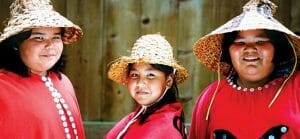
across British Columbia.”
Halapija says she believes cultural tourism is a natural fit for the Nisg̲a’a Nation. “I think you’ll always have authentic cultural experiences [here] because the Nisg̲a’a just want to talk and they want to chat and they want to teach and interact,” she says. “The sharing culture is incredibly important to the Nisg̲a’a people and hospitality is incredibly important.”
Growing the Field: The Importance of Partnerships
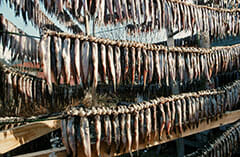
Perhaps one of the leading factors in the success of the cultural marketing initiative is the partnerships Mercer fostered both within the Nass Valley and in the surrounding communities.
As part of the initiative, Mercer built a relationship with Destination British Columbia, the Crown corporation responsible for promoting BC tourism, and worked with them to produce a video promoting tourism in the Nass Valley. The relationship led to partnerships with other nearby communities. “It was good working with them,” he says. “A lot came out of it.” Through the production of the video Mercer developed partnerships with City of Terrace, Regional District of Kitamat-Stikine, District of Stewart, and Kermodei Tourism.
Mercer also used the marketing and tourism initiative to develop and enhance relationships within the Nation both with entrepreneurs and the four village governments. Skipp says of Mercer that he was able to look at the big picture. “What Bert [Mercer] did…is look at the bigger playing field and think ‘how can we grow that?’” By linking tourist destinations together, the tourism initiative benefits all businesses and villages in the region.”
What the auto-tour does so well is give the visitor a reason, and a good one, to go to all four villages.
Halapija says that visitors to the Nass Valley rarely come just to visit one location on the tour. “What the auto-tour does so well is give the visitor a reason, and a good one, to go to all four villages,” she says. “Because very few people come here just for the museum. I’d say there’s a small portion of like diehard museum fanatics that would drive two hours just to see a museum.” She says that most people come up as part of a larger daytrip. “They’ll stop at Lava Lake and have lunch and they’ll stop at the Lava Tour signs and then they’ll come down to the museum and then they’ll go home.”
Key Challenges and Successes
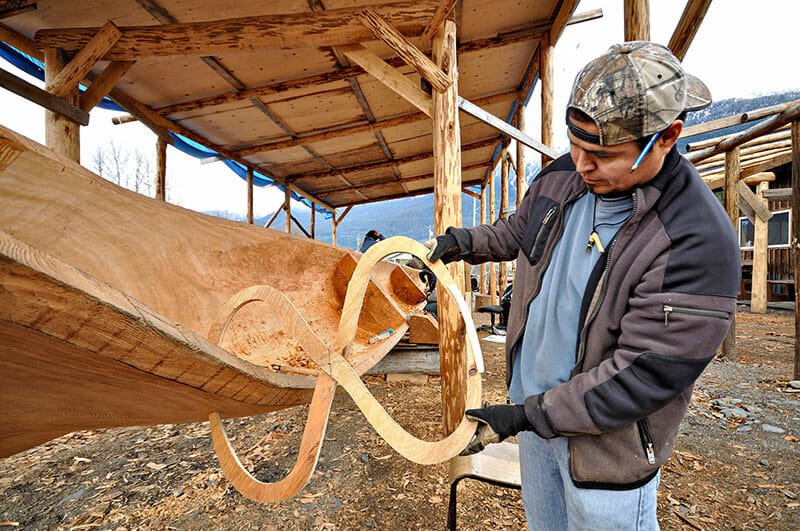
Government Dynamics: Mercer is the first to admit that his project faced challenges along the way. One of the more challenging aspects was working to ensure the initiative reflected the vision of each of the Nisg̱a’a communities’ leadership. Though he works for the Nisg̱a’a Lisims Government, Mercer worked closely with the governments of the four villages to develop and approve the auto-tour and brochure. Mercer has since developed a steering committee consisting of representatives from Nisg̱a’a Lisims Government and each of the four villages. “I think if I was to do stuff differently I’d make sure I had a steering committee to work with right from the start. That’s your stakeholders.” Mercer says. He says the steering committee helps to overcome the siloed nature of government structures. The committee developed a terms of reference that clearly outlines its scope, what kind of recommendations they can provide to leadership, and what types of projects they can become involved in.
Importance of Branding: In order to establish Nisg̱a’a Tourism as an international-quality product, Mercer worked closely to follow the established brand guidelines of the Nisg̱a’a Lisims Government. Designer Jim Skipp says following brand guidelines is of the utmost importance. “Everything that was done…aligns with the overall NLG brand.” He suggests that what hurts some other tourism initiatives is too many people “doing their own thing.”
Cultural Sensitivities: Mercer worked closely with Nisg̱a’a elders to ensure language was responsibly incorporated. Though the process took time, he recognizes the importance of including the language and cultural interpretations into the auto-tour. Providing wider access to culturally significant sites like the hot springs, and the Lava Bed Memorial Park required careful thought and planning. The hot springs, are increasingly becoming a destination for outside visitors and the Nation must manage that impact with a desire to protect its cultural sites. Mercer tells the story of a stagette party that visited the hot springs. “There must have been about 14 women there. They were drinking, and they wouldn’t listen to us.” Nisg̱a’a bylaw officers had to step in. “We have a lot of signs up for the hot springs site, but bylaw officers go in to make sure people are honouring what we have on our signs.”
Allowing Room for Growth: The auto-tour and brochure were purposefully designed to allow for growth of tourism in the region. As they continue to push development of tourism in their territory, Mercer and the Nisg̲a’a Lisims Government are completing work on a 6-room lodge that will be connected to Nisg̲a’a Highway 113, Vetter Lodge, as it is called, will be added to the auto-tour route and to the next printing of the accompanying brochure.
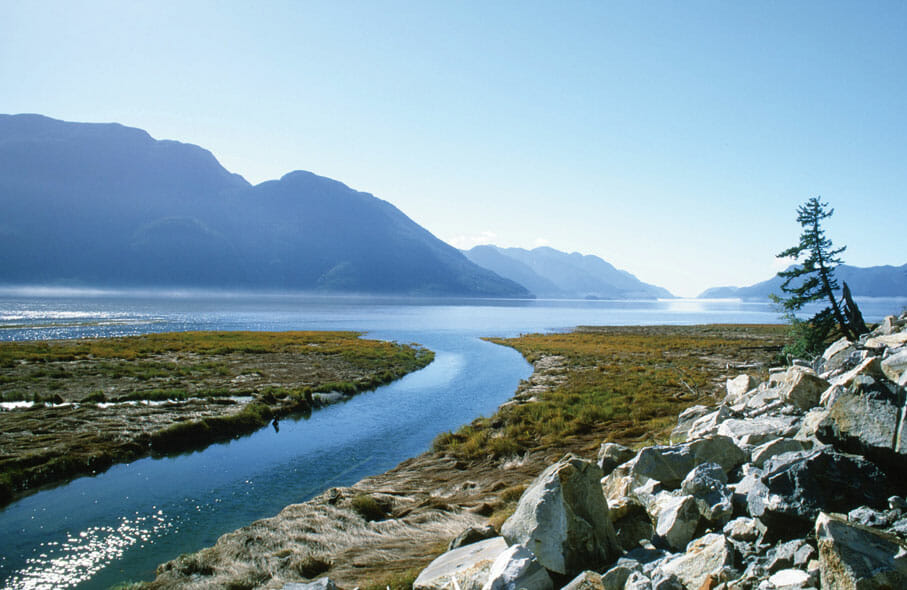
Cultural Outcomes
The cultural benefits of the project were many. The road signs guiding visitors along the auto-tour and the accompanying brochure provide a greater awareness and recognition of the Nisg̲a’a language and cultural values. In developing the project, Mercer worked extensively with the Ayuukhl Nisg̲a’a Department, and the Council of Elders to ensure correct and respectful interpretation of sites and language translation. Working with elders in this way is essential to ensuring the continuity and revitalization of the Nisg̲a’a language. Additionally, the auto-tour signs, brochure, and website all feature an expression of Nisg̲a’a art: the image of Txeemsim, the spirit who brought light to the Nass River Valley.
Learn more about language outcomes.
Economic Outcomes
By raising the profile of Nisg̲a’a territory as a tourism destination, the cultural marketing and tourism initiative buoys all businesses in the four villages, Vetter Falls Lodge, Gitwinksihlk Welcome House and Café, Bonnie Stanley’s U See Food U Eat It Catering and Fast Food, and Hlgu Isgwit Hot Springs—all of which are supported with funding from Coast Funds. As Aboriginal Tourism BC has noted, travelers partaking in Aboriginal Tourism tend to spend more money per trip than other tourists, spend more trip days in the province, and travel in larger parties. By focusing on cultural tourism and marketing, the Nisg̲a’a Lisims Government brings more funding to its territory and its entrepreneurs, than tourism devoid of the Nisg̲a’a culture. Nearby communities, municipalities, and businesses are tapping into this boom in cultural marketing. Incredibly, the project included ten partnerships with nearby communities and organizations.
Learn more about diversification outcomes.
Social Outcomes
As part of the development of the Nisg̲a’a cultural marketing and tourism initiative. 13 entrepreneurs and community members participated in a one-day training workshop put on by Aboriginal Tourism BC. The training included an introduction to Aboriginal Tourism BC including its programs, industry standards and market-ready standards to improve Nisg̲a’a entrepreneur’s competitiveness in tourism. It also included training on hospitality based on case studies, branding and booking tools to increase their profile to their target audience for tourism. In addition, 9 temporary jobs were created with this project for the website development, design work, road sign installation, and GIS mapping. The objective of the project was not to create direct employment, but rather to invest in marketing and tourism infrastructure that will in turn lead to job creation for Nisg̲a’a entrepreneurs and support existing businesses like the Nisg̲a’a Museum, U See Food U Eat It Restaurant, and Vetter Lodge. Indirect employment supported by the Nisg̲a’a tourism and marketing initiative is expected to grow as more visitors come to the Nass Valley each year.
Lear more about training outcomes.
Environmental Outcomes
Because of the enhanced and expanded auto-tour road signs and accompanying brochure guide, there is a great awareness in the Nass Valley of the Nisg̲a’a lands, including the Memorial Lava Bed Park, the first Provincial Park jointly managed by a First Nation and BC Parks; the Nass River, which sustains a bounty of life in the Valley; the Tseax River (Ksi Sii Aks), an important gravel stream bottom habitat for salmon and steelhead spawning and important source of food for bears; and Fishery Bay, the main Nisg̲a’a harvesting centre for eulachon where they are rendered into oil, an historic staple of Nisg̲a’a trade.
Lear more about research outcomes.
In 2014, Coast Economic Development Society approved funding for a project totalling $37,860 toward Nisg̲a’a Lisims Government’s development of a cultural tourism and marketing initiative.
Partnerships
- Aboriginal Tourism Association of BC
- Destination British Columbia
- Nisg̲a’a Village of Gitlaxt’aamiks
- Nisga’a Village of Gitwinksihlkw
- Nisg̲a’a Village of Gingolx
- Nisg̲a’a Village of Laxgalts’ap
- City of Terrace
- Kermodei Tourism Society
- Regional District of Kitimat-Stikine
- District of Stewart
- Skipp Design
Online Resources
- Nisg̲a’a Tourism
Nisg̲a’a Tourism Website - Nisg̲a’a Lisims Government
Website for the Nisg̲a’a Lisims Government - Northern BC Places To Go
Aboriginal BC highlights the Nisg̲a’a Museum in its list of places to visit - Nisg̲a’a Village of Gingolx Tourism
Tourism website for Nisg̲a’a Village of Gingolx - Anhluut’ukwsim Laxmihl Angwinga’asa’anskwhl NNisg̲a’a
BC Parks site for the Nisg̲a’a Memorial Lava Bed Park - Nass Valley and Lava Beds Driving Route
Destination BC’s information on the Nisg̲a’a auto-tour - Hli Goothl Wilp-Adokshl Nisg̲a’a
Website for the Nisg̲a’a Museum - Explore the Nisg̲a’a Nation along the Auto Tour Route British Columbia
Indigenous Canada, Oct 2017 - Nisg̲a’a Nation Launches Tourism Marketing Initiative
Coast Funds, Dec 2016 - Nass Valley Volcano: Tseax Crater and Nisg̲a’a Memorial Lava Bed Provincial Park
Northword, Aug 2014 - Aboriginal Tourism BC Backgrounder
Aboriginal Tourism BC - Nisg̱a’a-Owned Vetter Falls Lodge Now Open
Coast Funds, July 2018
Published On March 12, 2018 | Edited On January 23, 2023


